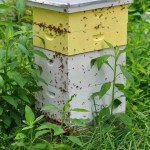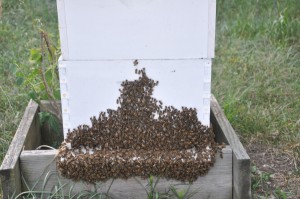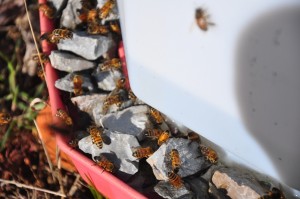A beekeeper asks:
About three weeks ago I caught a very large swarm and immediately placed it in two deep hive bodies with 10 frames in each. I looked in the hive today and found the top box was almost completely full of capped honey, lots of bees, but no brood. The bottom box, had some capped honey at the top corners of the frames, little pollen and two frames in the middle with some capped brood. I did not see the queen and my question is how to tell if a queen is present in the hive?
Phil’s reply:
I never worry about seeing the queen, unless I’m making nucs (I do not want to move her), re-queening, or doing a task where I really need her in hand. I depend on seeing eggs or larvae to determine her presence.
With this heavy nectar flow and a new swarm, you are not likely to see brood in both boxes, even with a big swarm. The bees are putting lots of nectar in now. If you are seeing eggs or larvae (uncapped brood) in the bottom box, you have a queen. Don’t worry about actually seeing her. If you look in the area (on these frames) where you are seeing the brood, that is the most likely place for her to be hanging out.
You may wish to put a honey super (or two) on that hive. I have 2 hives containing large swarms I have caught, which are putting honey in supers.
A beekeeper asks:
About three weeks ago I had a large swarm emerge from a hive (I saw and captured it). The top box in that hive is full of capped honey, but the bottom one is almost empty with only a few cells of capped brood. I did not see the queen. I’m concerned about the hive. Advice?
Phil’s reply:
You say there is some capped brood in the bottom hive body. That indicates that there was egg laying occurring less than three weeks ago, perhaps a few days longer if that is capped drone brood. It can take a hive between 2-3 weeks to produce a laying queen after it swarms and leaves capped queen cells. As I said in a recent post, queens emerge 7 to 8 days after the queen cells are capped. (And swarms will depart as soon as that happens.) Another week will pass before the virgin queen is ready to make her mating flights. During that time, she reaches sexual maturity and makes orientation flights. After successfully mating, she will start laying eggs in 2 to 3 days. Added up, it takes 2 to 3 weeks for the new queen to start laying eggs after a hive swarms. I would give it a few more days before considering installing a new queen. You may have a virgin, or a newly mated queen that has not yet started laying eggs.
I sometimes call this period, from just after the hive swarms until most of the brood in the hive emerges, a time of “apparent queenlessness”. It looks as though the colony is without a queen, but it may, in fact, be in the process of producing a new one. Many a beekeeper has contacted me at this time of year to tell me they thought a hive was queenless. They placed a queen in the hive or started to install one, and discovered eggs or young larvae. I advise patience before installing a replacement queen in a hive that seems to be queenless at this time of year.
A beekeeper asks:
I have a hive that has dwindled. There is a laying queen and I continually see eggs, but there is never brood. At one time I moved a frame of nurse bees into the hive, thinking that might be an issue, but it did not help. There are some capped drone cells which makes me wonder if the queen is not laying and workers are. The eggs seem normally positioned in the cells. Just curious what you thought.
Phil’s reply:
You may have a queen who has run out of sperm, so she is laying only drone eggs. (I have in the past called these infertile queens, but that doesn’t really sound right. They are fertile because they can lay eggs -just not fertilized eggs that develop into workers). Beekeepers often call them “drone layers”. With both laying workers and a queen that has run “dry”, you get only drone eggs. But if you’re seeing the queen, you probably do not have laying workers.
Laying workers is a condition that can develop in a hive after it becomes hopelessly queenless, when some of the workers respond to the lack of queen and brood pheromones by starting to lay eggs. Workers cannot mate, so when the do lay, the result is the same as when a queen dries – nothing but drone brood. Though workers are always capable of laying eggs, their urge to do so is suppressed by the pheromones present in a normal hive. Since brood pheromone plays a role in the suppression as well as pheromones from the queen, it takes several weeks for laying workers to develop even after the queen is gone. We can postpone this behavior by moving a frame or two of capped brood into a hive that has been queenless for a long period.
To help determine whether you have laying workers or a queen that has run out of sperm when you don’t see the queen and are finding only drone eggs, here is what to look for:
- Laying workers: Only drone brood in the hive, and seen in worker sized cells; multiple eggs in a cell (always more than one laying worker in hive, so more than one of them may lay in a cell); the drone brood is scattered (they miss cells). The workers do not have the instinct to lay in every cell and to position the eggs properly.
- Dry queen: Drone brood only, and seen in worker size cells; not scattered and no multiple eggs in cells. The queen is laying, just laying unfertilized eggs.




